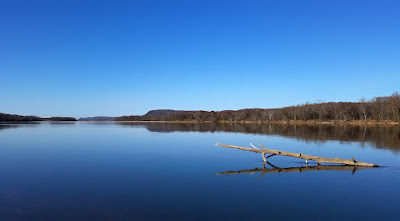"October extinguished itself in a rush of howling winds and driving rain and November arrived, cold as frozen iron, with hard frosts every morning and icy drafts that bit at exposed hands and faces."
― J.K. Rowling
But not here. I took the day off on Tuesday to check for tiger beetles at several locations along the Wisconsin River, including Spring Green Preserve where it was 78 degrees. We're getting much needed rain today (Saturday), so there will be no outdoor adventures. Perhaps tomorrow.
Apart from writing this blog, I'll likely play guitar, do some chores, and continue reading Richard Dawkins' latest book Flights of Fancy: Defying Gravity by Design and Evolution. Dawkins (and Rowling) can be somewhat controversial and polemical public figures, but I'm fans of both strictly for their intellectual achievements. I met Dawkins at a Free Thought event several years ago at Memorial Union and told him how my independent study of the avian realm helped me better understand the forces of differential reproductive success and descent with modification ― biological evolution.
It's my contention that a naturalistic view of life descending from common ancestry is a magnificent one. When I look upon a Dark-eyed Junco there is a vast divergence between us that goes back something like 300 million years ― neither of us are more evolved than the other; the species we belong to have evolved the same length of time. Instead, our adaptations and genetic changes in that timeframe went in entirely different directions for very important reasons. Keen observers will notice variations to be observed among juncos by species and subspecies, rendered via differential pressure and selection. And then all avians. And then all life. The patterns of evolution can be observed in nearly every taxonomic branch, but nowhere is it more accessible and obvious as it is with birds: geographical distribution, processes of selection, inheritable traits, phenotype, genotype, courtship behavior ― it's all there.
Evolution, eh? "But how come a giraffe has never given birth to a horse?" counters the biblical creationist. Well, that's because that isn't how evolution works ― the changes are subtle and gradual. "I accept micro evolution but not macro evolution" you'll often hear. The fact is there is no biological barrier nature can't overcome should the pressure and responses to it impact mutable genes. It's either that, or go extinct. In our narrow window of time a junco isn't going to lay an egg that hatches a tree sparrow or a gerbil. "If we evolved from apes, then why are there still apes?" is another creationist canard that's easily debunked. If American immigrants came from Europe, then why are there still Europeans? Though humans are technically apes (primates), we share common ancestry with chimpanzees, orangutans, gorillas, etc. But it's our shared common ancestor that's gone. We share common ancestry with every thing that has ever lived, extant or extinct ― the greater the genetic differences, the further back in time one must go to find that particular common ancestor. All life is related in this way.
As Charles Darwin said, there's a grandeur in this view in which we can regard every living thing a form of kin. An American Tree Sparrow knows almost nothing about its origins and doesn't in any way reciprocate appreciation in the way I admire it. But acknowledging these kind of differences is part of the charm and fascination I experience when studying and photographing wild creatures. Sadly, even those who accept biological evolution, only 33% (US Americans) hold that it's due purely by natural processes. I find it far more interesting and astonishing that all of this exists bravely on its own with no divine power watching over or guiding it. "But how did it all get started?" Whether abiogenesis or the origin of the Universe, I don't know ... and neither do you. The mystery is glorious, but let's not stop asking questions and thinking.
Spring Green's bluff and prairies were rendered golden and bronzed under the seasonal receding sunlight. I covered every nook and cranny I could think of but didn't find a single tiger beetle. I was very surprised. I thought that the warm weather and presence of Bronzed Tiger Beetles along the river would almost certainly translate to a few Festive or Punctured still roaming the desert prairie's sandy trails. Alas, none detected.
I even went up to the top of the bluff to check the rocky outcroppings for Splendid and Claybank, but zippo. This is all fine and well. It was still a wonderful day to hike some of my favorite haunts even though there wasn't much to photograph apart from the stunning landscape. Places once green, lush, and teaming with endless lifeforms now subdued, concealing the promise of spring's eventual resurgence.
I also checked the sandbars at Arena, but found only a single Bronzed Tiger Beetle.
Calm and quiet ... very relaxing.
And picturesque.
The Bronzed Tiger Beetles at the Sauk City Canoe Launch shoreline were still present, but rather than a half dozen individuals, I found only 2 or 3. I can tell from their maculation details that these are two of the same beetles I photographed last weekend.
What of them now?
Will they still be active the next warm day? Tomorrow, perhaps?
Part of the day's mission was simply to observe any tiger beetle during the month of November, something I've never done before. It would be interesting to know just how long they'll survive, but I think I'm finally going to call it a season. Perhaps another tiger beetler will check in on them and see how they're doing.
A final portrait ...
From a lot of steps.
All images © 2022 Mike McDowell
















